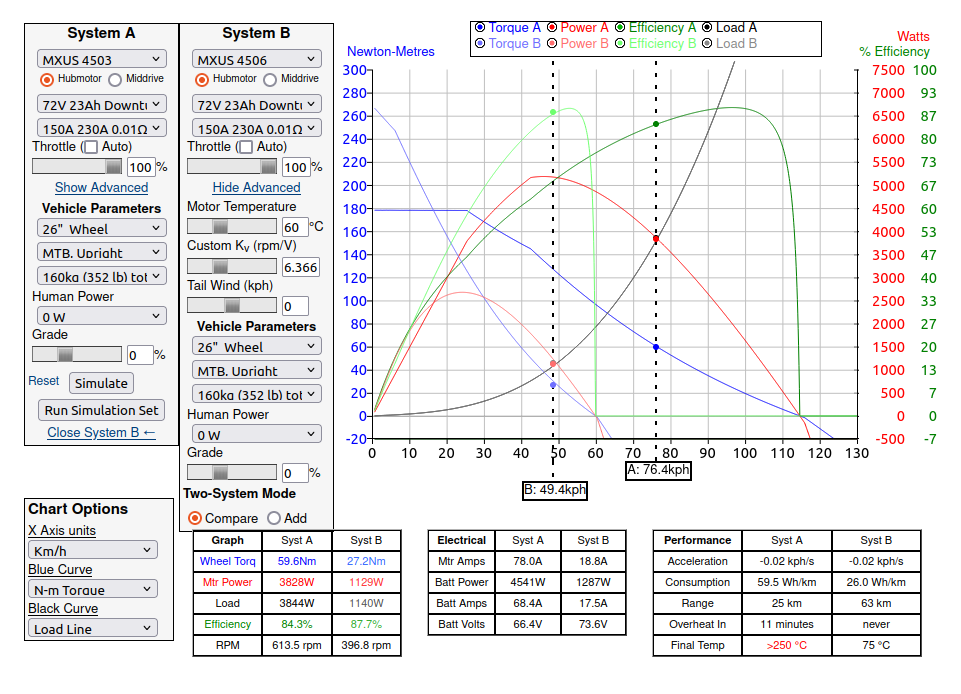Hello! Sorry to spam the forums, but my last post led me to decide on a leafmotor and there's many different windings.
I can only find motor simulator for Leaf 5T, does anyone have data to simulate other windings?
He's my dilemma. Looking at windings from similar MXUS motor, the torque advantage for slower windings seems to evaporate after ~15mph. And because I'm running so much power, I think torque below that might not matter anyways. I don't care about top speed but losing a bunch of torque starting at 10mph compared to faster winds doesn't look great. It's hard to know exactly but it appears motors with slower windings have less watts power overall above ~10mph, even at 72v.
I'm gonna run both ferromagnetic and hubsinks, because they're cheap so why not. And I'm running an FOC Sabvoton on LiPo. So I don't think I need to worry about heat or battery resistance below 3000w. If my musings are correct, at this voltage slow speed advantage of a low KV motor is significantly reduced. And even though I don't give a crap about speeds about 30mph I might be better off with a faster winding because overall power is higher and doesn't fall off near top speed.
I used MXUS for simulation but I'm pretty sure stock MXUS is pretty similar to ferrofluid+hubsinks Leafmotor as far as heat and KV ratings. Anyways, see attached picture of MXUS sim at different windings. Even though slower winding is better at a few mph the power handling of faster windings more than makes up for it.

here is my controller http://www.cnqsmotor.com/en/article_read/Sabvoton%20SVMC/SSC%20Series%20Brushless%20Sinusoidal%20Programable%20Motor%20Controller/537.html
Also, I'm running 26" tire
Am I correct that low-kv motors are bad for power/torque at this power level no matter the speed? Simulation sure looks like it. The extra torque below 10mph is just going to throw you off the bike IMO. And having shit power at 20mph, a normie human pedaling speed, doesn't seem great.
I can only find motor simulator for Leaf 5T, does anyone have data to simulate other windings?
He's my dilemma. Looking at windings from similar MXUS motor, the torque advantage for slower windings seems to evaporate after ~15mph. And because I'm running so much power, I think torque below that might not matter anyways. I don't care about top speed but losing a bunch of torque starting at 10mph compared to faster winds doesn't look great. It's hard to know exactly but it appears motors with slower windings have less watts power overall above ~10mph, even at 72v.
I'm gonna run both ferromagnetic and hubsinks, because they're cheap so why not. And I'm running an FOC Sabvoton on LiPo. So I don't think I need to worry about heat or battery resistance below 3000w. If my musings are correct, at this voltage slow speed advantage of a low KV motor is significantly reduced. And even though I don't give a crap about speeds about 30mph I might be better off with a faster winding because overall power is higher and doesn't fall off near top speed.
I used MXUS for simulation but I'm pretty sure stock MXUS is pretty similar to ferrofluid+hubsinks Leafmotor as far as heat and KV ratings. Anyways, see attached picture of MXUS sim at different windings. Even though slower winding is better at a few mph the power handling of faster windings more than makes up for it.

here is my controller http://www.cnqsmotor.com/en/article_read/Sabvoton%20SVMC/SSC%20Series%20Brushless%20Sinusoidal%20Programable%20Motor%20Controller/537.html
Also, I'm running 26" tire
Am I correct that low-kv motors are bad for power/torque at this power level no matter the speed? Simulation sure looks like it. The extra torque below 10mph is just going to throw you off the bike IMO. And having shit power at 20mph, a normie human pedaling speed, doesn't seem great.


